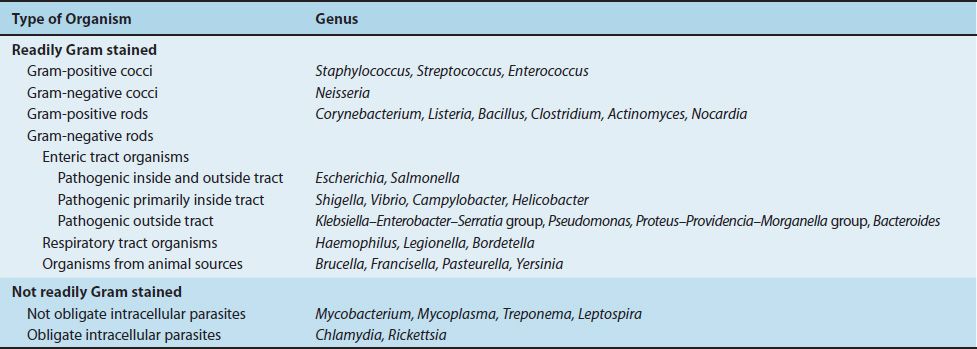14
Overview of the Major Pathogens & Introduction to Anaerobic Bacteria
CHAPTER CONTENTS
OVERVIEW OF THE MAJOR PATHOGENS
The major bacterial pathogens are presented in Table 14–1 and described in Chapters 15 through 26. So that the reader may concentrate on the important pathogens, the bacteria that are less medically important are described in a separate chapter (see Chapter 27).
TABLE 14–1 Major Bacterial Pathogens

Table 14–1 is divided into organisms that are readily Gram stained and those that are not. The readily stained organisms fall into four categories: gram-positive cocci, gram-negative cocci, gram-positive rods, and gram-negative rods. Because there are so many kinds of gram-negative rods, they have been divided into three groups:
(1) Organisms associated with the enteric tract
(2) Organisms associated with the respiratory tract
(3) Organisms from animal sources (zoonotic bacteria)
For ease of understanding, the organisms associated with the enteric tract are further subdivided into three groups: (1) pathogens both inside and outside the enteric tract, (2) pathogens inside the enteric tract, and (3) pathogens outside the enteric tract.
As is true of any classification dealing with biologic entities, this one is not entirely precise. For example, Campylobacter causes enteric tract disease but frequently has an animal source. Nevertheless, despite some uncertainties, subdivision of the large number of gram-negative rods into these functional categories should be helpful to the reader.
The organisms that are not readily Gram stained fall into six major categories: Mycobacterium species, which are acid-fast rods; Mycoplasma species, which have no cell wall and so do not stain with Gram stain; Treponema and Leptospira species, which are spirochetes too thin to be seen when stained with Gram stain; and Chlamydia and Rickettsia species, which stain well with Giemsa stain or other special stains but poorly with Gram stain. Chlamydia and Rickettsia species are obligate intracellular parasites, whereas members of the other four genera are not.
Table 14–2 presents the 10 most common “notifiable” bacterial diseases in the United States for 2009 as compiled by the Centers for Disease Control and Prevention. Note that only notifiable diseases are included and that certain common conditions such as streptococcal pharyngitis and impetigo are not included. Two sexually transmitted diseases, chlamydial infection and gonorrhea, are by far the most common diseases listed, followed by salmonellosis, syphilis, and Lyme disease in the top five.
TABLE 14–2 The 10 Most Common Notifiable Bacterial Diseases in the United States in 20111

Stay updated, free articles. Join our Telegram channel

Full access? Get Clinical Tree


